The Yushima Formation, also known as the Tatsunokuchi Formation, is a palaeontological formation in Japan, dating to the Lower Pliocene period.
The Yushima Formation, also known as the Tatsunokuchi Formation, is a palaeontological formation in Japan, dating to the Lower Pliocene period.
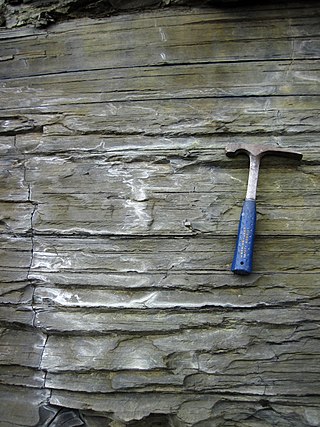
Shale is a fine-grained, clastic sedimentary rock formed from mud that is a mix of flakes of clay minerals (hydrous aluminium phyllosilicates, e.g. kaolin, Al2Si2O5(OH)4) and tiny fragments (silt-sized particles) of other minerals, especially quartz and calcite. Shale is characterized by its tendency to split into thin layers (laminae) less than one centimeter in thickness. This property is called fissility. Shale is the most common sedimentary rock.
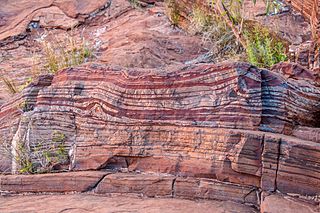
Banded iron formations are distinctive units of sedimentary rock consisting of alternating layers of iron oxides and iron-poor chert. They can be up to several hundred meters in thickness and extend laterally for several hundred kilometers. Almost all of these formations are of Precambrian age and are thought to record the oxygenation of the Earth's oceans. Some of the Earth's oldest rock formations, which formed about 3,700 million years ago (Ma), are associated with banded iron formations.

A calcium–aluminium-rich inclusion or Ca–Al-rich inclusion (CAI) is a submillimeter- to centimeter-sized light-colored calcium- and aluminium-rich inclusion found in carbonaceous chondrite meteorites. The four CAIs that have been dated using the Pb-Pb chronometer yield a weighted mean age of 4567.30 ± 0.16 Myr. As CAIs are the oldest dated solids, this age is commonly used to define the age of the Solar System.
The exposed geology of the Bryce Canyon area in Utah shows a record of deposition that covers the last part of the Cretaceous Period and the first half of the Cenozoic era in that part of North America. The ancient depositional environment of the region around what is now Bryce Canyon National Park varied from the warm shallow sea in which the Dakota Sandstone and the Tropic Shale were deposited to the cool streams and lakes that contributed sediment to the colorful Claron Formation that dominates the park's amphitheaters.

In organic chemistry, an electrophilic addition reaction is an addition reaction where a chemical compound containing a double or triple bond has a π bond broken, with the formation of two new σ bonds.
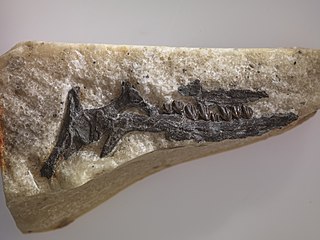
Leaellynasaura is a genus of small herbivorous ornithischian dinosaurs from the Albian stage of the Early Cretaceous, first discovered in Dinosaur Cove, Australia. The only known species is Leaellynasaura amicagraphica. It was described in 1989, and named after Leaellyn Rich, the daughter of the Australian palaeontologist couple Tom Rich and Patricia Vickers-Rich who discovered it. The specific name, amicagraphica, translates to "friend writing" and honours both the Friends of the Museum of Victoria and the National Geographic Society for their support of Australian paleontology.

The Siderian Period is the first geologic period in the Paleoproterozoic Era and lasted from 2500 Ma to 2300 Ma. Instead of being based on stratigraphy, these dates are defined chronometrically.
Serendipaceratops is a genus of herbivorous ornithischian dinosaur, possibly an ankylosaur, from the early Cretaceous Period of Australia. The type species, S. arthurcclarkei, was named in 2003.
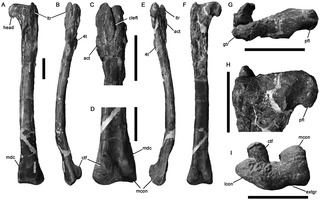
Timimus is a genus of small coelurosaurian theropod dinosaur from the Early Cretaceous of Australia. It was originally identified as an ornithomimosaur, but now it is thought to be a different kind of theropod, possibly a tyrannosauroid.
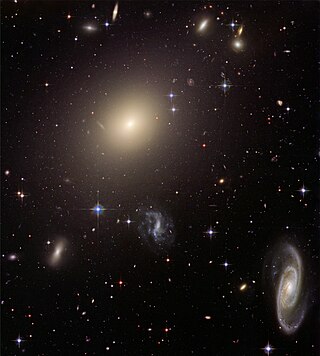
A brightest cluster galaxy (BCG) is defined as the brightest galaxy in a cluster of galaxies. BCGs include the most massive galaxies in the universe. They are generally elliptical galaxies which lie close to the geometric and kinematical center of their host galaxy cluster, hence at the bottom of the cluster potential well. They are also generally coincident with the peak of the cluster X-ray emission.

The San Juan Basin is a geologic structural basin located near the Four Corners region of the Southwestern United States. The basin covers 7,500 square miles and resides in northwestern New Mexico, southwestern Colorado, and parts of Utah and Arizona. Specifically, the basin occupies space in the San Juan, Rio Arriba, Sandoval, and McKinley counties in New Mexico, and La Plata and Archuleta counties in Colorado. The basin extends roughly 100 miles (160 km) N-S and 90 miles (140 km) E-W.

Batrachosuchus is a genus of temnospondyl that existed from the Early to Middle Triassic of southern Africa and the Blina Shale of Australia.
In physiology, isobaric counterdiffusion (ICD) is the diffusion of different gases into and out of tissues while under a constant ambient pressure, after a change of gas composition, and the physiological effects of this phenomenon. The term inert gas counterdiffusion is sometimes used as a synonym, but can also be applied to situations where the ambient pressure changes. It has relevance in mixed gas diving and anesthesiology.
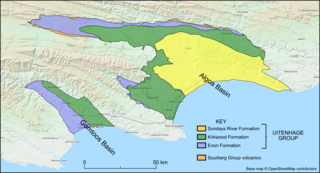
The Kirkwood Formation is a geological formation found in the Eastern and Western Cape provinces in South Africa. It is one of the four formations found within the Uitenhage Group of the Algoa Basin – its type locality – and in the neighbouring Gamtoos Basin. Outcrops of the Kirkwood are also found along the Worcester-Pletmos, Herbertsdale-Riversdale, Heidelberg-Mossel Bay, and Oudtshoorn-Gamtoos basin lines. At these basins the Kirkwood Formation underlies the Buffelskloof Formation and not the Sundays River Formation.

An iron planet is a type of planet that consists primarily of an iron-rich core with little or no mantle. Mercury is the largest celestial body of this type in the Solar System, but larger iron-rich exoplanets may exist.

Galaxias Chaos is an area of broken landscape in the Cebrenia quadrangle of Mars, located at 34.1° N and 213.6° W. It is 234.0 km across and was named after an albedo feature name. Galaxias Chaos may be caused by sublimation of an ice-rich deposit.

An anemic galaxy is a type of spiral galaxy characterized by a low contrast between its spiral arms and its disk.
Chubutemys was an extinct genus of meiolaniform turtle. It lived during the Early Cretaceous of Argentina, around the Albian-Aptian border, within the Puesto La Paloma Member of the Cerro Barcino Formation. It is known from most of the skeleton and carapace, and part of the skull.

The Uitenhage Group is one of three geological groups, which comprise the onshore and offshore post-Karoo middle to lower Upper Mesozoic geological rock units in South Africa. Stratigraphically, the Uitenhage Group overlies the Suurberg Group and is overlain by the Algoa Group. It contains four formations that range in age from late Early Jurassic and late Early Cretaceous in age.